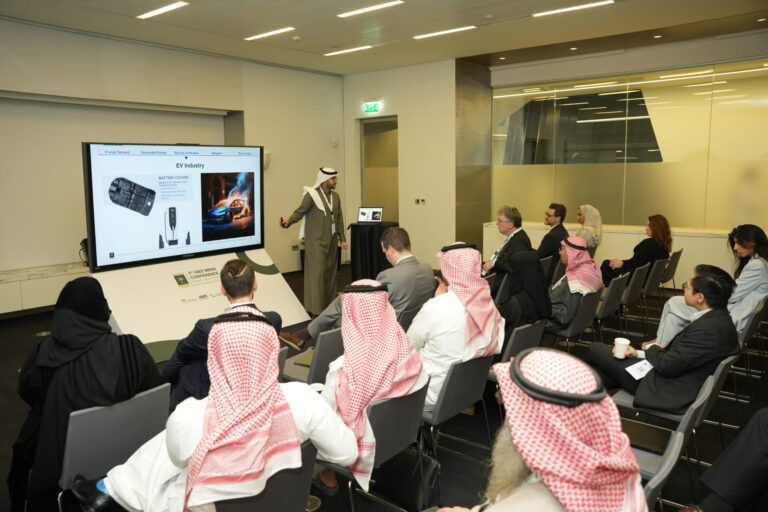Decarbonized oil production may sound like an oxymoron, but Antoine Halff, senior researcher at the Center on Global Energy Policy at Columbia University and former chief oil analyst at the International Energy Agency, explains that it is indeed possible, and Saudi Arabia is leading the way by taking strict measures to prevent accidental methane leaks during oil extraction.
Methane is a far more potent greenhouse gas than carbon dioxide in the short term. It frequently leaks into the atmosphere in the course of extracting fossil fuels, including oil and gas. Saudi Aramco has taken significant steps to reduce methane emissions, capturing natural gas released from oil fields and using it in part to generate electricity.
Using novel satellite technology, Halff’s analytics firm, Kayrros, worked with KAPSARC to peg the Kingdom’s oil field methane emissions at 780 kilotons in 20221, only a quarter of what the International Energy Agency had estimated for the nation.
The findings put Saudi Arabia second only to Norway in terms of methane emitted during oil production. However, Saudi Arabia leads the way in avoiding flaring, the burning off of methane that releases carbon dioxide. As The Economist noted, Saudi Aramco has since 2012 “flared less than 1% of this potent planet-cooking compound, compared with perhaps 4% that America’s shalemen set alight.”
Clarifying the difference between flaring and venting, Halff explains, “Venting means releasing methane into the atmosphere. Flaring means burning the methane and turning it into CO2, which is a lesser evil in the short-term (but still a big problem in the longer term). Flaring also releases some methane, because flares are not fully efficient, but their main output is CO2.”
Halff notes that at COP21—the 2015 United Nations climate talks that yielded the Paris Agreement—“there was almost no discussion of methane, because while we were painfully aware of the problem of fast-rising methane concentrations in the atmosphere, we had very limited visibility on the precise sources of methane emissions.
Since then, Kayrros and KAPSARC have made great strides in the capacity to track methane, and have gained a much deeper understanding of where it comes from. “Saudi Arabia is unique among oil and gas producers, in terms of avoiding it,” says Halff, explaining that this is “due in part to policies that actually were adopted by Saudi Arabia even before we could measure methane.”
Other countries could emulate Saudi Arabia’s practices, says Halff, attributing Aramco’s low oil field methane emissions not to their rock formations, but rather to technology and standards.
“It’s really a question of operating practices. If I had to speculate about the reason why Saudi Arabia is doing so well, I’d say it has the culture of operational excellence in general.”
Antoine Halff
“The idea of capturing the value of oil not only to burn for energy but as a material to transform into all kinds of sophisticated products is front and center in Saudi Arabia’s economy.”
More ways to decarbonize
Another key strategy to decarbonize the oil industry is to reduce greenhouse gas emissions from petrochemicals. Electric vehicles alone present a massive and growing need for advanced plastics, which are produced from hydrocarbons, Halff notes.
“Saudi Arabia is very much at the forefront of developing advanced petrochemicals, and plastics,” he notes. “The refineries in the system are very integrated with petrochemical facilities. The idea of capturing the value of oil as a material to transform into all kinds of sophisticated products is central to the country’s economy.”
Powering petrochemical processes with electricity produced from alternative sources instead of natural gas is one way to decarbonize the sector.
Saudi Arabia aims to produce half of its power through renewables by 2030, up from only about 3% today. The country has an abundance of sun and wind, but there are also challenges, including the sand and dust that coat solar panels during frequent windstorms.
“There’s clearly a very ambitious effort to develop green energy not only for domestic use, but even for export,” Halff says.
Capturing the green hydrogen opportunity
To power its own economy, Saudi Arabia is investing in renewable energy and blue hydrogen—fuel produced from natural gas, where the associated carbon emissions are captured and sequestered underground. While the practice is still in its early stages commercially worldwide, Saudi Arabia is creating a carbon sequestration hub at Jubail, on its east coast, that aims to store up to 9 million tons of carbon dioxide per year by 20273. The country is also pioneering technology to extract carbon dioxide from the atmosphere and use or sequester it.
“How much of what’s being undertaken in Saudi Arabia can be emulated and replicated elsewhere, and how much is very unique to Saudi Arabia’s specific circumstances and unique asset base?” Halff asks.
Along with its copious oil reserves and technical know-how, Saudi Arabia’s political structure and the ability to make executive decisions about how to manage its oil resource differs from many countries. But, Halff continues, “there are also a lot of things that can be emulated, in terms of methane abatement and low methane-intensity production. Saudi Arabia is in a position to lead the rest of the industry in showing how oil can be produced with a much smaller methane footprint and much more responsibly.”
And even as the country invests heavily in renewables, oil will likely remain synonymous with Saudi Arabia.
“It’s often said that if the world really weans itself from fossil fuels, there will always be residual oil consumption,” says Halff. “Saudi Arabia is positioned to be the last man standing because of its reserves, its low production costs, its very good operating practices and its management of the resource. Few other countries can claim to be in the same position.”
Reference
1. https://www.kapsarc.org/news/kapsarc-and-kayrros-unveil-saudi-arabias-methane-emission-landscape-using-satellite-technology/ and https://www.kapsarc.org/research/publications/using-satellite-technology-to-measure-greenhouse-gas-emissions-in-saudi-arabia/
2. https://www.economist.com/business/2024/06/02/how-saudi-aramco-plans-to-win-the-oil-endgame
3. https://www.globalccsinstitute.com/news-media/insights/saudiarabiaccsefforts/




